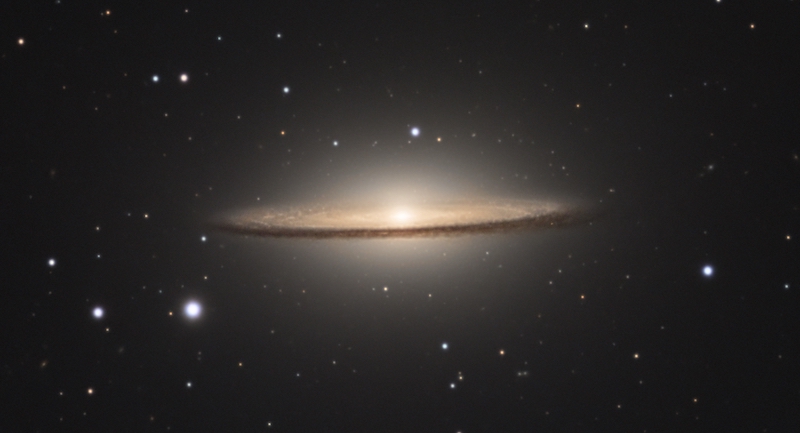M104, Sombrero Galaxy
Published 18 Aug 2022
Click the image above for full resolution
About this object
Description courtesy of Sky Safari Pro: The Sombrero Galaxy was discovered in 1767 by Pierre Mechain. Charles Messier made a note of this object and five others (now recognized as M 104 through M 109) in his personal list of objects, but did not include them in his original published catalog. William Herschel independently discovered the object in 1784, and noted the presence of a "dark stratum" in the galaxy's disc. M 104 was "officially" included in the Messier Catalog in 1921 by Camille Flammarion, who found Messier's personal list, and identified the Sombrero with Herschel's H I.43 and with NGC 4594. M104 lies 29.3 million light years distant in the constellation Virgo. It's 9th magnitude in brightness and about 8x4 arc minutes in size. M104 is almost but not quite edge on. We see it about 6 degrees south of its equatorial plane.
M 104 has a mildly active nucleus, as evidenced by visible emission lines and radio emission. Based on the stellar dynamics in its core, a research group demonstrated in the 1990s that a supermassive black hole, 1 billion times the mass of the Sun, is present in the center of the Sombrero Galaxy.
The Sombrero has a relatively large number of globular clusters (you can see many in the image above as faint points within the outer halo); observations have produced population estimates in the range of 1200 to 2000. This is high compared to the Milky Way and other galaxies with small bulges, but similar to other galaxies with large bulges.
This image was taken with my 6" refractor and full frame ASI 6200 CMOS camera. The image is cropped and comprised of (160) 60sec Luminance exposures for a total of 160min and near 170min of RGB exposures for a total exposure time of 11.2 hrs. The image was taken using 1x1 binning giving a resolution of .64 arc sec/pixel and upsampled using drizzle in processing to a resolution of .32 arc sec/pixel.
Description courtesy of Sky Safari Pro: The Sombrero Galaxy was discovered in 1767 by Pierre Mechain. Charles Messier made a note of this object and five others (now recognized as M 104 through M 109) in his personal list of objects, but did not include them in his original published catalog. William Herschel independently discovered the object in 1784, and noted the presence of a "dark stratum" in the galaxy's disc. M 104 was "officially" included in the Messier Catalog in 1921 by Camille Flammarion, who found Messier's personal list, and identified the Sombrero with Herschel's H I.43 and with NGC 4594. M104 lies 29.3 million light years distant in the constellation Virgo. It's 9th magnitude in brightness and about 8x4 arc minutes in size. M104 is almost but not quite edge on. We see it about 6 degrees south of its equatorial plane.
M 104 has a mildly active nucleus, as evidenced by visible emission lines and radio emission. Based on the stellar dynamics in its core, a research group demonstrated in the 1990s that a supermassive black hole, 1 billion times the mass of the Sun, is present in the center of the Sombrero Galaxy.
The Sombrero has a relatively large number of globular clusters (you can see many in the image above as faint points within the outer halo); observations have produced population estimates in the range of 1200 to 2000. This is high compared to the Milky Way and other galaxies with small bulges, but similar to other galaxies with large bulges.
This image was taken with my 6" refractor and full frame ASI 6200 CMOS camera. The image is cropped and comprised of (160) 60sec Luminance exposures for a total of 160min and near 170min of RGB exposures for a total exposure time of 11.2 hrs. The image was taken using 1x1 binning giving a resolution of .64 arc sec/pixel and upsampled using drizzle in processing to a resolution of .32 arc sec/pixel.
Image Details
- Optics : Stellarvue SVX 152T refractor @f8 1200mm FL
- Mount: Paramount MYT
- Camera: ZWO ASI6200
- Filters: Chroma 50mm LRGB
- Exposure (min): LRGB 160:174:170:168 11.2 hrs, 1x1 binning
- Automation Control: The Sky X, Voyager, PrimaluceLab Eagle 4
- Guiding: Unguided
- Processing Software: PixInsight, PS CC 2022
- Location: Stark Bayou Observatory, Ocean Springs, MS
- Sky: Typical SQM 19.6-20.1, Bortle 5, Suburban
- Date: 2 April - 27 May 2022







